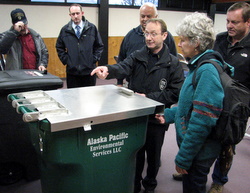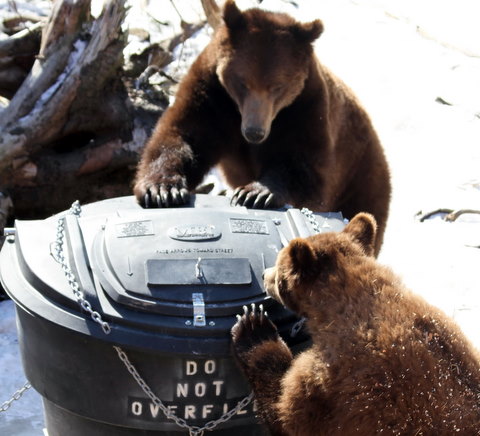Residents in a few select neighborhoods in Sitka will be trying out a new kind of bear-resistant trash can this spring.
The local sanitation company is doing a field test of two prospective containers. Both are mostly plastic, and neither is considered “bear-proof.” All the authorities want to do is to frustrate brown bears looking for an easy meal, in the hope that they move on.
Click here for iFriendly audio.
At Sitka’s Fortress of the Bear, spring has definitely sprung. A seafood processor recently provided the habitat with 3,000 pounds of excess frozen salmon. This is good news for the five brown bears who live here, and the at least thirty bald eagles and one-hundred or more ravens who have just dropped by for lunch.
Last year, a local group known as the Bear Task Force arranged to leave a bear-resistant trash can in the Fortress, with a tasty treat sealed inside. Fortress co-director Les Kinnear describes what (you probably already suspect) happened.
“We left one in the habitat for a couple of days, because they drug it into the pool. It’s like they wanted to have more time to work on it. It was plastic. They can destroy even substantial plastic products.”
Kinnear would be the first to admit that it was not a fair test. The bears here are routinely given challenges to get to their food. It’s placed in a hollowed-out tree trunk, or inside a buoy ball with a small opening. Kinnear calls them “puzzle feeders.”
Last year’s trash can test was not all that unusual for the two full-grown male brown bears.
“So when our bears approach a trash can, they see that as another challenge. A wild bear doesn’t exactly see that. A wild bear is there because he’s hungry, not because he’s interested or playful. His primary interest is gathering food as economically as possible.”
The can happened to be one that Alaska Pacific Environmental Services is using in this spring’s field test in Sitka, though the lid is now made out of custom-welded aluminum instead of plastic. APES, also known locally as Stragier Sanitation, is deploying twenty-four cans in two varieties, one a manufactured bear-resistant can with a locking lid, and the other the more conventional can with the aluminum lid.

Police Chief Sheldon Schmidt demonstrates a can with a modified aluminum lid. (Photo Robert Woolsey/KCAW)
Andrew Thoms, who sits on Sitka’s bear Task Force, stresses that neither is bear-proof.
“I think the cans are going to be bear resistant. They’re not going to be a can that a bear can just walk up to, open up, and grab the trash. Or, they’re not going to be a can that a bear can walk by, knock over, and garbage spills all over the street.”
The theory is that bears, working mainly in the limited hours of darkness, won’t want to invest the effort.
“If the bear wanted to get in the can, it could spend some time doing it, but if it spends twenty hours out there, by that time the police or ADF&G can see what’s going on and chase the bear away.”
Phil Mooney, the local wildlife biologist with the Alaska Department of Fish & Game, agrees.
“Especially with young bears moving through, they can tip them over but if they can’t get into it, it’s very typical for our bears to hit-and-run. Knock it over, grab something out of it, go to the next can.”
Mooney is pretty certain that – like the bears in the Fortress – we’re not just training wild bears to a higher level.
“Nope. No, we’re going to be able to respond. One of the issues is that by the time dispatch gets the call, and they can respond and we can respond, the bear is already two blocks away, and moving. They’re quick to learn that an easy meal is nice, but they’re not going to spend a lot of time drawing attention to themselves.”
Mooney, along with police, is the front-line of Sitka’s response to bears. In 2009, bear calls peaked at over 200. Nineteen bears were destroyed or removed from the area that summer. Calls tapered significantly in the last two years, but Mooney expects it to start to creep up again.
“We’re going to see more bear activity this summer than we did last year, slowly increasing as those voids that were created in the landscape and habitat out there are filled in by other bears.”
The new cans have been placed at homes in the Indian River neighborhood – Sitka’s primary bear corridor – the Cascade St. neighborhood, and at both ends of the road system. In September, Alaska Pacific Environmental Services will survey customers to see which cans they preferred, and how they worked out.
APES is footing the bill for the field test. Andrew Thoms, with the Bear Task Force, says if it’s a success, his group’s next job will be to figure out how to bring more cans to town, and how to deploy them. There may be some efficiencies in buying cans with Juneau, since APES is contemplating a similar trash system in that city.
Les Kinnear, meanwhile, says his bears are happy to help out if more cans need to be tested in the future.
“That’s the nature of the beast, is to be inquisitive. They got to be bears by being very, very strong and clever and powerful and capable.”
Note: According to Phil Mooney, as of May 16th a total of 17 new cans had been deployed, with the remainder in reserve once this summer’s bear “hot spots” are known.
































